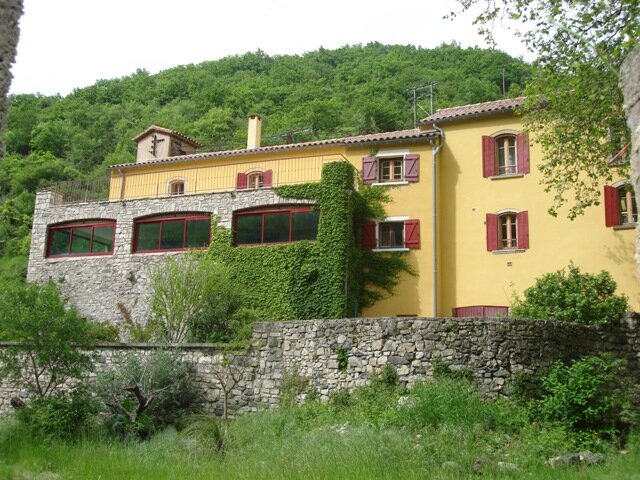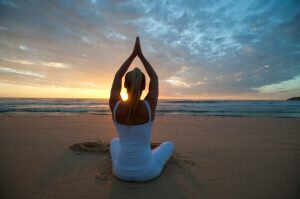

Lucy Gillmore from the Guardian writes: Who needs Boots? On a course in Languedoc you can discover how to make your own lotions and cosmetics.
‘Ylang ylang is the Marmite of essential oils,” Jenny Gay, homeopath, reiki practitioner and our teacher for the weekend, explained. “It’s a female aphrodisiac, so cosmetics companies tend to bung it in everything. But you either love it or you hate it.”
I hate it, so it wasn’t going in my face cream. Instead I slopped a dollop of pale green aloe vera gel into a small jar. Next, a drizzle of organic apricot kernel oil from a test tube. Whisking vigorously, I watched as the mixture turned cloudy. Finally, the essential oils: two drops of rose (good for broken capillaries and dry skin), two of geranium (balancing), one of frankincense (a natural preservative with – those magic words – anti-ageing properties). In just a few minutes I had created my own organic face cream. I couldn’t believe how easy it was. And it had a dreamy, delicate scent.
The last time I had been in a lab was at school. But this cool, shiny space underneath a rustic farmhouse in a remote corner of southern France couldn’t be further removed from the Bunsen burners and sulphurous smoke of my chemistry lesson. Heady floral fragrances swirled around the room, and the result was a lot more useful than a dish of copper sulphate crystals.
This organic cosmetics-making course is the creation of Petre Sefton: not, as you might imagine, a glamorous French Coco Chanel-type, but a warm and enthusiastic former business publisher from the Cotswolds. After almost dying from septicaemia she became interested in the healing properties of plants and went hunting for a medicinal plant farm in France.
“The Herault region in the Languedoc,” she explained, “is the birthplace of western traditional herbal medicine. The area attracts botanists from all over France because of the amazing plant varieties that will grow here.”
In 2002, Petre bought the 250-acre Domaine de Laval de Nize and renamed it L’Alabrena, or salamander, from the local Occitan dialect. Now she grows her own aromatherapy ingredients, including clary sage, mint, Californian poppies, ginkgo, arnica and verbena. She has become a passionate advocate for holistic living, studying remedies dating back to 1673, and running courses on aromatherapy, organic perfume- and cosmetics-making, as well as selling her own skincare range, essential oils and natural remedies.
The mustard-coloured farmhouse dates back to the middle ages and is at the end of a single-track road that snakes through the thickly forested, wild boar-trampled, Val de Nize in Languedoc Roussillon. As well as four rustic-chic rooms in the hotel – with wooden floors, beamed ceilings, antiques, panoramic mountain views and, naturellement, luscious toiletries – there’s a simpler gite next door where walkers bed down.
There is much to do in the region’s lively capital, Montpellier, and the packed beaches of the Mediterranean coast are just an hour’s drive away. The nearest village is medieval Lunas – 10 minutes by car or an hour’s walk – which has a picturesque watermill and friendly bar with tables shaded by plane trees.
The surrounding landscape is craggy and wild. This is the High Languedoc national park, the southern part of the Massif Central that rolls down to the coastal plain and the salt-water lagoons of the Camargue. The Val de Nize was settled by the Romans (hence all the chestnut trees, Petre told us) and is also close to the old pilgrimage route from Rome to Santiago de Compostela in Spain. Pilgrims once stayed in the Domaine or L’Alabrena – and still do.
We had arrived on Friday and wound our way through crumbling honey-coloured villages and past dusty vineyards to Lunas. Crossing a medieval bridge over the trout-filled river Nize we reached the end of the narrow valley where we found L’Alabrena hunkered into a slope covered in woodland.
We spent our first day familiarising ourselves with the local ingredients. Strolling along the lane, Elizabeth, our local expert and guide, pointed out comfrey, which can be used to make a salve to treat bumps and bruises, and fumitory, used in an infusion to help conditions such as eczema. Bear garlic sprouted from the banks, its delicate white flower making a tasty addition to salads (as we discovered that night at dinner). We learned that garlic halts tooth decay at the same time as sorting out your digestive tract. Nettles, which also go by the far friendlier name of hidgy pidgy, are a diuretic and good for the kidneys when taken as a tea or tissane. Lemon balm – a cousin of mint – aids digestion, while the yellow goo that seeps from the stalk of greater celandine is a natural wart treatment. Who needs Boots?
In the classroom the next morning Petre and Jenny lined up bottles of base oils and essential oils and we went into sensory overload as we sniffed and they talked therapeutic benefits. And then finally, we got our hands on a test tube.
Outside the air was alive with birdsong, the chirruping of cicadas and buzzing bees, while inside, it was all silent concentration. After the face cream, we made a toner using floral waters (bi-products of the distillation process that extracts essential oils from the different plants) as well as the essential oils themselves. Then a face oil, lip and hand balm and a body scrub. We mixed coarse sea salt with almond oil, olive oil or sunflower oil, poured in a little at a time so it wasn’t too sticky, then added a revitalising scrub. Voilà. I could see it now . . . “Lucy’s Organics”.
On the Sunday we made our own perfume and body oil. As I bent over the tiny receptacle with my dropper, I felt my science lab days coming back to me. A top note of melissa, citrusy and fresh, mandarin, to balance my chakras, geranium for inner peace and a base note of rosewood for contentment. I was the new Coco Chanel, swanning around murmuring, “A woman who doesn’t wear perfume has no future.” My future, I thought, mixing my scent with 100ml of grapeseed oil to create an aromatic body oil, was not just looking bright. My future was geranium and orange.
• Golearnto.com (0844 502 0445) has three-night weekend Make Your Own Cosmetics courses for £379pp, including full-board and all classes from May-Oct.
The nearest airport is Montpellier, about an hour’s drive away, served by Ryanair from Stansted and Bristol and easyJet from Gatwick and Luton. You can also fly to Beziers.
To read the full article click here: cosmetics course Languedoc
*Please note that this course is no longer available – click here for our full range of <a href=”https://golearnto.com” target=”_blank”>activity and learning holidays</a>*






 Designed by
Designed by